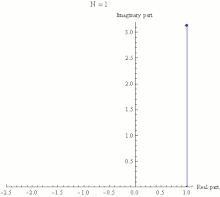This is an old revision of this page, as edited by Danstronger (talk | contribs) at 14:30, 18 December 2018 (Compromise? Considered perhaps a supreme example is pretty verifiable. "Emotional brain" is not a well-established name for the orbitofrontal cortex.). The present address (URL) is a permanent link to this revision, which may differ significantly from the current revision.
Revision as of 14:30, 18 December 2018 by Danstronger (talk | contribs) (Compromise? Considered perhaps a supreme example is pretty verifiable. "Emotional brain" is not a well-established name for the orbitofrontal cortex.)(diff) ← Previous revision | Latest revision (diff) | Newer revision → (diff) For other uses, see List of topics named after Leonhard Euler § Euler's identities.| Part of a series of articles on the |
| mathematical constant e |
|---|
 |
| Properties |
| Applications |
| Defining e |
| People |
| Related topics |
In mathematics, Euler's identity (also known as Euler's equation) is the equality
where
- e is Euler's number, the base of natural logarithms,
- i is the imaginary unit, which satisfies i = −1, and
- π is pi, the ratio of the circumference of a circle to its diameter.
Euler's identity is named after the Swiss mathematician Leonhard Euler. It is considered to be an example of mathematical beauty, perhaps a supreme example, as it shows a profound connection between the most fundamental numbers in mathematics.
Mathematical beauty
Euler's identity is often cited as an example of deep mathematical beauty. Three of the basic arithmetic operations occur exactly once each: addition, multiplication, and exponentiation. The identity also links five fundamental mathematical constants:
- The number 0.
- The number 1.
- The number π (π = 3.141...).
- The number e (e = 2.718...), which occurs widely in mathematical analysis.
- The number i, the imaginary unit of the complex numbers.
Furthermore, the equation is given in the form of an expression set equal to zero, which is common practice in several areas of mathematics.
Stanford University mathematics professor Keith Devlin has said, "like a Shakespearean sonnet that captures the very essence of love, or a painting that brings out the beauty of the human form that is far more than just skin deep, Euler's equation reaches down into the very depths of existence". And Paul Nahin, a professor emeritus at the University of New Hampshire, who has written a book dedicated to Euler's formula and its applications in Fourier analysis, describes Euler's identity as being "of exquisite beauty".
The mathematics writer Constance Reid has opined that Euler's identity is "the most famous formula in all mathematics". And Benjamin Peirce, a noted American 19th-century philosopher, mathematician, and professor at Harvard University, after proving Euler's identity during a lecture, stated that the identity "is absolutely paradoxical; we cannot understand it, and we don't know what it means, but we have proved it, and therefore we know it must be the truth".
A poll of readers conducted by The Mathematical Intelligencer in 1990 named Euler's identity as the "most beautiful theorem in mathematics". In another poll of readers that was conducted by Physics World in 2004, Euler's identity tied with Maxwell's equations (of electromagnetism) as the "greatest equation ever".
A study of the brains of sixteen mathematicians found that the medial orbitofrontal cortex, which lights up for music, poetry, pictures and other art, lit up more consistently for Euler's identity than for any other formula.
Books in popular mathematics about Euler's identity include A Most Elegant Equation: Euler's formula and the beauty of mathematics, by David Stipp (2017), and Euler's Pioneering Equation: The most beautiful theorem in mathematics, by Robin Wilson (2018).
Explanation
Main article: Euler's formula See also: Complex exponents with a positive real base
Fundamentally, Euler's identity asserts that is equal to -1. The expression is a special case of the expression , where z is any complex number. In general, is defined for complex z by extending one of the definitions of the exponential function from real exponents to complex exponents. For example, one common definition is:
Euler's identity therefore states that the limit, as n approaches infinity, of is equal to -1. This limit is illustrated in the animation to the right.

Euler's identity is a special case of Euler's formula, which states that for any real number x,
where the inputs of the trigonometric functions sine and cosine are given in radians.
In particular, when x = π,
Since
and
it follows that
which yields Euler's identity:
Generalizations
Euler's identity is also a special case of the more general identity that the nth roots of unity, for n > 1, add up to 0:
Euler's identity is the case where n = 2.
In another field of mathematics, by using quaternion exponentiation, one can show that a similar identity also applies to quaternions. Let {i, j, k} be the basis elements; then,
In general, given real a1, a2, and a3 such that a1 + a2 + a3 = 1, then,
For octonions, with real an such that a1 + a2 + ... + a7 = 1, and with the octonion basis elements {i1, i2, ..., i7},
History
It has been claimed that Euler's identity appears in his monumental work of mathematical analysis published in 1748, Introductio in analysin infinitorum. However, it is questionable whether this particular concept can be attributed to Euler himself, as he may never have expressed it. Moreover, while Euler did write in the Introductio about what we today call Euler's formula, which relates e with cosine and sine terms in the field of complex numbers, the English mathematician Roger Cotes (who died in 1716, when Euler was only 9 years old) also knew of this formula and Euler may have acquired the knowledge through his Swiss compatriot Johann Bernoulli.
Robin Wilson states the following.
We've seen how it can easily be deduced from results of Johann Bernoulli and Roger Cotes, but that neither of them seems to have done so. Even Euler does not seem to have written it down explicitly – and certainly it doesn't appear in any of his publications – though he must surely have realized that it follows immediately from his identity , e = cos x + i sin x. Moreover, it seems to be unknown who first stated the result explicitly….
See also
Notes
- The term "Euler's identity" (or "Euler identity") is also used elsewhere to refer to other concepts, including the related general formula e = cos x + i sin x, and the Euler product formula.
References
- Dunham, 1999, p. xxiv.
- Stepanov, S. A. (7 February 2011). "Euler identity". Encyclopedia of Mathematics. Retrieved 7 September 2018.
- Gallagher, James (13 February 2014). "Mathematics: Why the brain sees maths as beauty". BBC News Online. Retrieved 26 December 2017.
{{cite news}}: Italic or bold markup not allowed in:|website=(help) - Paulos, 1992, p. 117.
- Nahin, 2006, p. 1.
- Nahin, 2006, p. xxxii.
- Reid, chapter e.
- Maor, p. 160, and Kasner & Newman, p. 103–104.
- Wells, 1990.
- Crease, 2004.
- Zeki et al., 2014.
- Conway & Guy, p. 254–255.
- ^ Sandifer, p. 4.
- Euler, p. 147.
- Wilson, p. 151-152.
Sources
- Conway, John H., and Guy, Richard K. (1996), The Book of Numbers, Springer ISBN 978-0-387-97993-9
- Crease, Robert P. (10 May 2004), "The greatest equations ever", Physics World
- Dunham, William (1999), Euler: The Master of Us All, Mathematical Association of America ISBN 978-0-88385-328-3
- Euler, Leonhard (1922), Leonhardi Euleri opera omnia. 1, Opera mathematica. Volumen VIII, Leonhardi Euleri introductio in analysin infinitorum. Tomus primus, Leipzig: B. G. Teubneri
- Kasner, E., and Newman, J. (1940), Mathematics and the Imagination, Simon & Schuster
- Maor, Eli (1998), e: The Story of a number, Princeton University Press ISBN 0-691-05854-7
- Nahin, Paul J. (2006), Dr. Euler's Fabulous Formula: Cures Many Mathematical Ills, Princeton University Press ISBN 978-0-691-11822-2
- Paulos, John Allen (1992), Beyond Numeracy: An Uncommon Dictionary of Mathematics, Penguin Books ISBN 0-14-014574-5
- Reid, Constance (various editions), From Zero to Infinity, Mathematical Association of America
- Sandifer, C. Edward (2007), Euler's Greatest Hits, Mathematical Association of America ISBN 978-0-88385-563-8
- Stipp, David (2017), A Most Elegant Equation: Euler's formula and the beauty of mathematics, Basic Books
- Wells, David (1990), "Are these the most beautiful?", The Mathematical Intelligencer, 12: 37–41, doi:10.1007/BF03024015
- Wilson, Robin (2018), Euler's Pioneering Equation: The most beautiful theorem in mathematics, Oxford University Press
- Zeki, S.; Romaya, J. P.; Benincasa, D. M. T.; Atiyah, M. F. (2014), "The experience of mathematical beauty and its neural correlates", Frontiers in Human Neuroscience, 8, doi:10.3389/fnhum.2014.00068
{{citation}}: CS1 maint: unflagged free DOI (link)

 is equal to -1. The expression
is equal to -1. The expression  , where z is any complex number. In general,
, where z is any complex number. In general, 
 is equal to -1. This limit is illustrated in the animation to the right.
is equal to -1. This limit is illustrated in the animation to the right.









